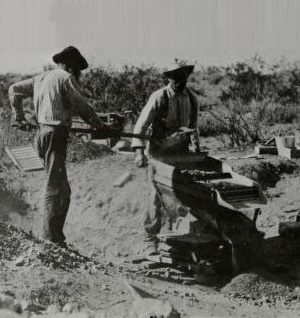There are many more methods to find gold than I will cover here, but lets discuss a few of the most common methods used by the small scale gold prospector.
1. Gold Panning
Gold Panning is the most common and inexpensive method to prospect for gold. It is very simple with a little practice to learn the basics of gold panning. You simply put a shovel full of gravels into the pan and move the pan from side to side underwater to separate the gold from the gravels. Since the gold is the heaviest element in the stream, the gold will fall to the bottom of the pan, and by tipping the pan at a slight angle, the gravels and other lighter material will sweep out of the pan.
Eventually all that will be left in the pan is gold (hopefully!) and the heavy black sands. Pans are great for their portability and ability to sample different areas quickly. They are limited in how much material they can process, since it will take several minutes to process a small amount of gravels.
2. Sluice box
A sluice box is a very simple and effective tool designed to find placer gold in a river or stream. It is a long narrow trough with riffles that you shovel gravels into to process. The sluice box is placed parallel to the stream flow so that fast flowing water will wash over the riffles. It uses the natural action of the water to separate the heavier gold from the lighter gravels.
The gold will get trapped in the riffles of the sluice, while the lighter gravels will get washed downstream with the current. Sluice boxes have been used for hundreds of years, and are a simple way to process much more material than by just using a gold pan.
3. Dry Washers
Rather than using water turbulence to separate heavy gold from gravels, a dry washer uses air and vibration. Material must be completely dry for a dry washer to work efficiently. They are typically used in areas where water is not available, mainly in arid desert away from streams and rivers.
In the US they are used extensively in the southwest states like Nevada, California, and Arizona.

A pair of miners using a dry washer to look for gold in Southern California.
4. Suction Dredges
A dredge is essentially an underwater vacuum cleaner. It sucks up streambed material using a gasoline powered suction hose. The gravels are pulled up through the hose and run through a sluice box.
The gravels are processed in the same way as described with the sluice box. The biggest benefit to using a suction dredge is the gas powered pump, which literally sucks the material to the surface, rather than having to manually place the gravels in the sluice with a shovel and bucket.
An experienced dredger can process lots of material, which will result in much higher gold recovery than other small-scale methods.
Read: Suction Dredging for Gold
5. Metal Detectors
A metal detector is an electronic device designed to find metal buried in the ground. The detector has a long shaft with a search coil that you hover just above the surface of the ground, and when it goes over a piece of metal you will get an audible sound.
While metal detectors are extremely effective for finding gold, they also have a very steep learning curve. To be successful, it is important to invest in a quality metal detector that is designed specifically for finding gold. There is literally TONS of metal in the ground; old rusty nails, cans, boot tacks, lead bullets, brass casings, etc. And a prospector has to be able to distinguish the sound of a gold nugget from the thousands of pieces of “trash” targets out there.
Even a highly skilled metal detector operator will spend a lot of time digging trash. Unlike other methods, a metal detector will miss a lot of small gold because it requires a large enough piece of gold to get an audible tone, but if you are truly interested in finding large nuggets, a metal detector might be your best option.
Next: Crevicing for Gold in Bedrock Cracks
